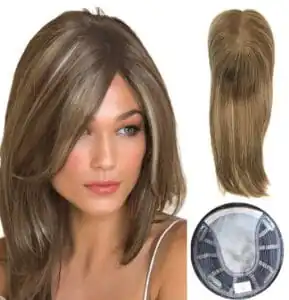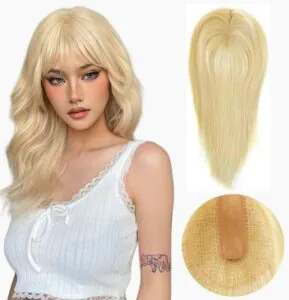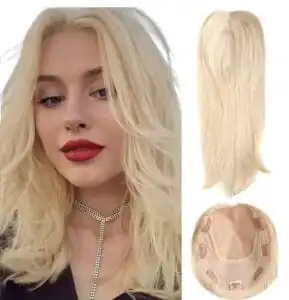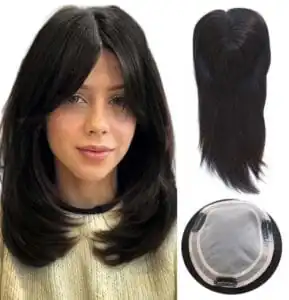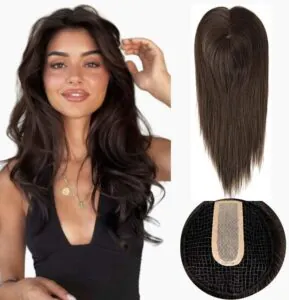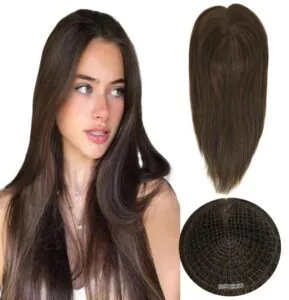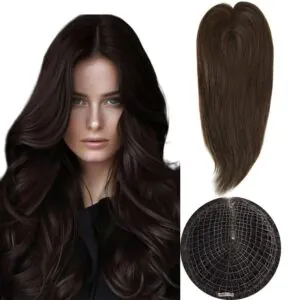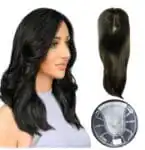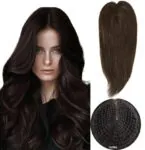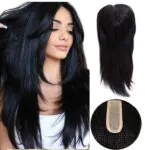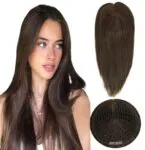Hi, everyone! I’m Sabine, your average 30-something woman who’s had her fair share of battles with… sparse hair. That’s right, not thin hair, not thinning hair—sparse. You know, the kind where you’re constantly tilting your head just right to hide the patchy spots, or praying no one stands behind you in bright sunlight? Yeah, that’s me.
But today, I’m here to share my journey to embracing hair toppers for sparse hair and all the lessons I’ve learned along the way. So, grab a cup of coffee, settle in, and let’s talk sparse hair, toppers, and everything in between!
Why Sparse Hair Deserves a Hair Topper
Let’s cut to the chase: sparse hair is stressful. You can spend hundreds of dollars on shampoos, serums, and DIY avocado masks, but sometimes, you just want an instant fix—something that hides the problem now.
That’s where a hair topper for sparse hair comes in.
Think of a hair topper as a little wiglet (isn’t that a fun word?) that sits snugly on the crown of your head, blending seamlessly with your existing hair. Unlike full wigs, toppers don’t cover your entire scalp, so you can still rock your natural hairline. And they’re not just practical—they’re also a huge confidence booster.
What Causes Sparse Hair?
Before we dive deeper into toppers, let’s talk about why sparse hair happens in the first place. It’s not just about genetics, folks—though, let’s be honest, family traits do play a role. Here are some of the main culprits:
- Hormones Gone Wild
Hormonal changes—thanks, menopause or postpartum life—can send your hair into a shedding frenzy. - Stress (The Hair Enemy)
Ever heard of telogen effluvium? It’s a fancy term for hair falling out due to stress, illness, or trauma. So, yes, that deadline at work could be the reason your parting looks wider. - Diet Drama
Crash diets, vitamin deficiencies, and lack of protein can weaken your hair. It’s like your scalp saying, “Feed me better, Sabine!” - Styling Overload
Guilty of overusing heat tools, tight hairstyles, or chemical treatments? Same. Turns out, your hair doesn’t appreciate being yanked, fried, or bleached repeatedly. Who knew? - Medical Conditions
From alopecia to thyroid issues, certain health conditions can wreak havoc on your hairline.
How Hair Toppers Save the Day
When my sparse hair became more noticeable, I went from denial to desperation. I tried everything—volumizing sprays, blow-drying upside down, even praying to the hair gods. Then, one day, I discovered hair toppers, and it was a total game-changer.
Here’s why I swear by them:
- Instant Volume and Coverage: No more worrying about those embarrassing scalp peeks. A hair topper fills in the gaps like magic.
- Customizable Options: Whether your sparse spots are at the crown, hairline, or sides, there’s a topper for every need.
- Lightweight and Comfortable: Unlike full wigs, toppers are breathable and don’t feel like you’re wearing a hat in summer.
- Versatility: You can style toppers just like your natural hair—curl it, straighten it, or toss it in a messy bun.
How to Choose the Right Hair Topper for Sparse Hair
Picking a hair topper can feel overwhelming at first (trust me, I spent hours Googling “hair topper for sparse hair wiglet” like a madwoman). But here are some tips to make it easier:
- Match the Color
The goal is to make your topper look natural, so matching the color to your hair is crucial. Some brands even offer color swatches to help. - Size Matters
Measure the sparse area to ensure the topper covers it completely. Most toppers are categorized by base size, so pay attention to those details. - Material Choices
- Synthetic Hair: Affordable and low-maintenance but less natural-looking.
- Human Hair: Pricier but blends better and offers more styling flexibility.
- Attachment Methods
- Clips: Quick and secure but might tug on fragile hair.
- Tapes or Adhesives: Great for sensitive scalps but require regular maintenance.
Maintaining Sparse Hair Like a Pro
Even with a trusty topper, it’s important to care for your natural hair. Here’s how I’ve learned to maintain my sparse locks:
- Gentle Shampooing
Ditch the harsh sulfates and opt for mild, nourishing shampoos that won’t strip your hair. I love products with biotin and keratin for a little extra TLC. - Scalp Care Is Key
A healthy scalp equals healthier hair. Use scalp scrubs or massagers to boost circulation and clear buildup. - Protective Styling
Avoid tight ponytails, braids, or buns that pull on your sparse areas. Loose, low-maintenance styles are your best friend. - Regular Trims
I know it’s hard to let go of those precious strands, but trimming split ends prevents further breakage. - Nourishment from Within
Load up on hair-friendly foods like salmon, eggs, spinach, and nuts. And don’t forget those biotin supplements!
My Favorite Hair Topper Hacks
I’ll admit it: wearing a topper felt weird at first. But after some trial and error, I figured out a few tricks:
- Blend It Like a Pro: Use a bit of dry shampoo on both your hair and the topper to create a seamless transition.
- Secure Those Clips: A little spritz of hairspray before clipping the topper in place helps it stay put.
- Style Together: Curl or straighten your natural hair with the topper to make everything look cohesive.
Embrace the Hair You Have (Sparse or Not)
Let’s get one thing straight: sparse hair isn’t a flaw. It’s just another part of who you are. Whether you choose to wear a topper, try regrowth treatments, or rock your natural hair, what matters most is feeling confident and fabulous.
And trust me, the right hair topper can do wonders for your self-esteem. It’s not just about covering up sparse spots—it’s about taking control and embracing your beauty in a way that works for you.
So, to all my fellow sparse-haired sisters out there, I say: don’t let your hair woes hold you back. Try a topper, have some fun with it, and remember—you’re gorgeous, patchy spots and all.
Cheers to fuller hair and fuller hearts!
Love,
Sabine

